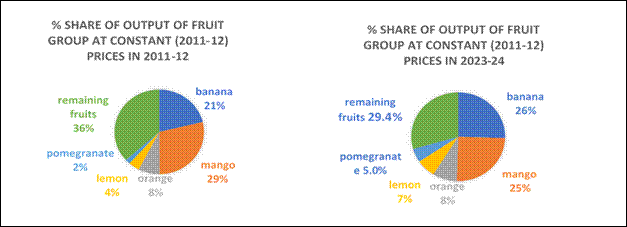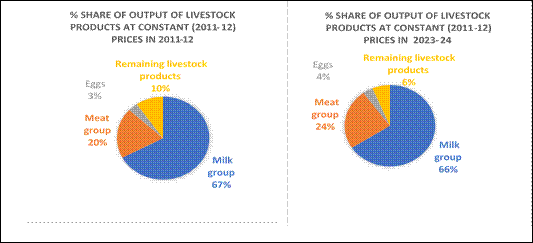Syllabus: GS3/Economy, Agriculture
Context
- The National Statistics Office (NSO), Ministry of Statistics and Programme Implementation (MoSPI) released the annual publication of “Statistical Report on Value of Output from Agriculture and Allied Sectors (2011-12 to 2023-24)”.
About
- It is a comprehensive document which provides detailed tables on values of output of Crop, Livestock, Forestry & logging and Fishing & aquaculture sectors of Agriculture & allied activities from 2011-12 to 2023-24 at both current and constant (2011-12) prices.
Key Highlights
- Overall Growth: Gross Value Added (GVA) at current prices grew by 225%, from ₹1,502 thousand crore in 2011–12 to ₹4,878 thousand crore in 2023–24.
- Gross Value of Output (GVO) at constant prices increased by 54.6%, from ₹1,908 thousand crore to ₹2,949 thousand crore.
- Sectoral Contribution to GVO (2023–24, at constant prices):
| Sector | Contribution to GVO | Notable Trends |
| Crop sector | ₹1,595 thousand crore (54.1%) | Largest contributor |
| Livestock | ₹919 thousand crore | Fastest growing |
| Forestry | ₹227 thousand crore | Moderate growth |
| Fishing & Aquaculture | Share rose to 7.0% (from 4.2%) | Rapidly rising |
- Crop Sector Details: Cereals + Fruits & Vegetables contributed 52.5% of total crop GVO, Paddy & Wheat contributed 85% of cereal GVO.
- Top Cereals GVO States (2023–24): Uttar Pradesh, Madhya Pradesh, Punjab, Telangana, and Haryana collectively contributed 53% of cereal GVO.

- Condiments & Spices: Top State Madhya Pradesh (19.2%) followed by Karnataka (16.6%) and Gujarat (15.5%).
- Livestock Sector: GVO rose from ₹488 to ₹919 thousand crore.
- Milk is dominant but share decreased from 67.2% to 65.9%.
- Meat share has increased from 19.7% to 24.1%.
- Fishing & Aquaculture: Contribution increased from 4.2% in 2011-12 to 7.0% in 2023-24.
- The share of inland fish has decreased from 57.7% to 50.2% whereas, the share of marine fish has increased from 42.3% to 49.8% during 2011-12 to 2023-24.
- Significant shifts in GVO (at constant prices) in Fisheries has been observed in the two major contributing States of West Bengal and Andhra Pradesh.

Importance Agriculture and Allied Sectors
- Contribution to GDP and GVA: The sector contributed around 18% to India’s Gross Value Added (GVA) in 2023–24.
- Employment Generation: It is the largest employer in the country. About 45% of India’s workforce is engaged in agriculture and allied activities (as per Periodic Labour Force Survey – PLFS 2022–23).
- Food Security: Ensures food security for over 1.4 billion people through production of cereals, pulses, vegetables, fruits, dairy, fish, and livestock products.
- Key to successful implementation of the Public Distribution System (PDS) and food subsidy schemes.
- Contribution to Exports: India is among the top exporters of rice, spices, marine products, cotton, tea, coffee, and buffalo meat.
- Rural Development and Poverty Alleviation: Drives rural income growth, supports rural infrastructure, and boosts consumption.
- Strategic and Political Importance: Plays a critical role in political stability due to its impact on inflation, rural distress, and food prices.
- Agriculture often features centrally in policy debates, budget allocations, and election manifestos.
Government Initiatives
- Pradhan Mantri Kisan Samman Nidhi (PM-KISAN): PM-KISAN is a central sector scheme launched in 2019 to supplement financial needs of land holding farmers, subject to exclusions.
- Pradhan Mantri Fasal Bima Yojana (PMFBY): It was launched in 2016 in order to provide a simple and affordable crop insurance product to ensure comprehensive risk cover for crops to farmers against all non-preventable natural risks.
- Agriculture Infrastructure Fund (AIF): The Fund of Rs. 1 lakh crore under the scheme will be disbursed from FY 2020-21 to FY2025-26 and the support under the scheme will be provided for the duration of FY2020-21 to FY2032-33.
- National beekeeping and Honey Mission (NBHM): It is a Central Sector Scheme launched in 2020 under Atma Nirbhar Bharat Abhiyan for overall promotion and development of scientific beekeeping & to achieve the goal of “Sweet Revolution”.
- Namo Drone Didi: It is a Central Sector Scheme for a period from 2024-25 to 2025-26.
- The scheme aims to provide drones to 15000 selected Women Self Help Group (SHGs) for providing rental services to farmers for agriculture purposes (application of fertilizers and pesticides).
- Soil Health Card (SHC): Provides information to farmers on nutrient status of their soil along with recommendation on appropriate dosage of nutrients to be applied for improving soil health and its fertility.
- National Mission on Edible Oil (NMEO)-Oil Palm (NMEO-OP): It has been launched in 2021 in order to promote oil palm cultivation for making the country Aatamnirbhar in edible oils.
- e-NAM (National Agriculture Market): Pan-India electronic trading platform integrating APMCs.
- Aims at transparent, competitive prices for farmers.
- National Livestock Mission (NLM): Focuses on breed improvement, fodder development, and entrepreneurship in livestock.
- Pradhan Mantri Matsya Sampada Yojana (PMMSY): Comprehensive development of the fisheries sector with focus on infrastructure, processing, and exports.
Conclusion
- The agriculture and allied sectors are not just about food production—they are the backbone of India’s economic resilience, social equity, and ecological sustainability.
- Strengthening these sectors is vital for achieving SDGs, ensuring inclusive growth, and making India Atmanirbhar (self-reliant).
Source: PIB
Previous article
India-US Trade Deal To Finalise Soon
Next article
India’s First Maritime NBFC Launched